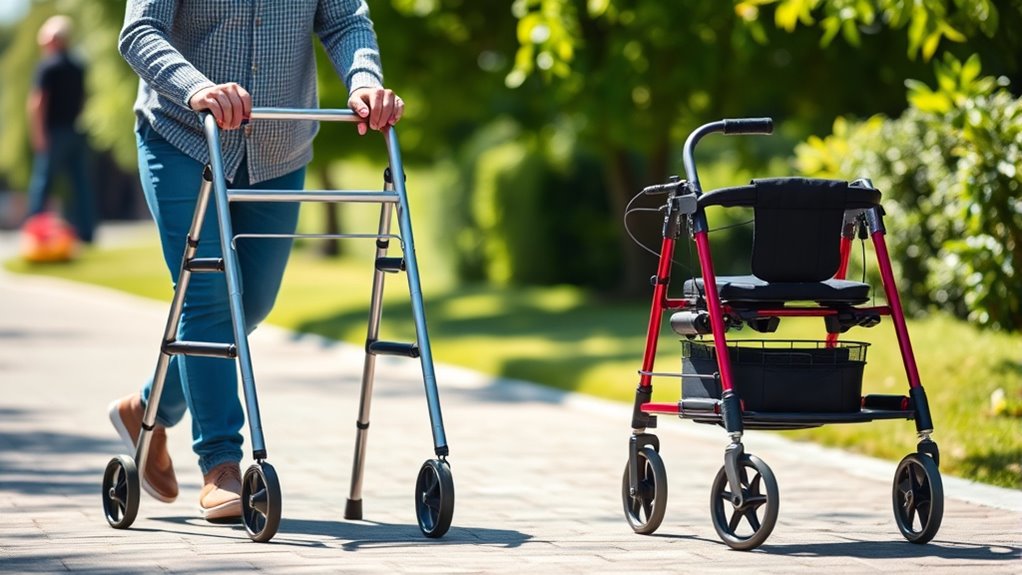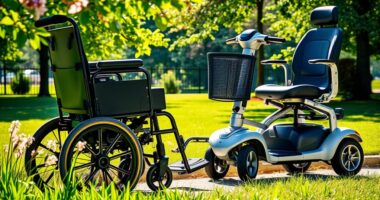When choosing between walkers and rollators, consider their stability and ease of use. Walkers offer a solid frame that provides steady support, ideal for uneven surfaces and indoor safety. Rollators are more maneuverable and adjustable, making outdoor travel easier and more natural. Both have safety features, but rollators often include brakes and seats for added convenience. To find the best fit for your environment and needs, understanding these pros and cons is essential. Keep exploring to discover which option suits you best.
Key Takeaways
- Walkers offer greater stability on uneven surfaces but require lifting, while rollators provide easier maneuverability with wheels.
- Rollators are better suited for indoor and outdoor use due to their ability to handle various terrains.
- Walkers provide solid support without wheels, reducing risk of slipping on uneven floors.
- Rollators include safety features like brakes and locking mechanisms, enhancing safety during rest or sitting.
- Choice depends on environment, physical ability, and need for stability versus ease of movement.

When choosing mobility aids, understanding the differences between walkers and rollators is essential. Both options provide support, but they serve different needs based on your lifestyle and environment. If you primarily move around indoors, your focus should be on indoor safety, which includes stability, ease of use, and maneuverability. Walkers tend to be more straightforward, offering a sturdy frame without wheels, which means you get a solid base for balance and support. They are less likely to slip or roll unintentionally, making them a safer choice for uneven or cluttered indoor spaces. However, walkers require you to lift or step them forward, which can be tiring if you need to move over longer distances or struggle with strength or balance. On the other hand, rollators come equipped with wheels, usually four, and often include features like brakes, seats, and baskets. This design makes them more adaptable to different terrains and easier to maneuver, especially if your indoor environment is smooth and predictable. They allow you to walk more naturally, similar to how you would without support, reducing fatigue and making movement less cumbersome. When considering terrain adaptability, rollators excel because their wheels help navigate various surfaces, including carpets, tile, or uneven flooring. This feature makes them suitable if you need a mobility aid for both indoor and some outdoor use, providing versatility that walkers might lack. Conversely, walkers are generally limited to flat, even surfaces; their lack of wheels means they aren’t ideal for outdoor terrain or uneven floors inside your home. If your mobility needs include *transitioning* between different environments, a rollator’s adaptability can be a significant advantage, helping you maintain independence across multiple settings. It’s also important to think about safety features like brakes and locking mechanisms, which are typically more sophisticated on rollators, adding an extra layer of security when you sit or rest. Meanwhile, walkers often require you to lift or reposition them, which might pose a risk if you have limited strength or stability. Additionally, choosing a device with proper visual cues can help you better assess your environment and prevent falls. Ultimately, your choice should depend on your specific needs—if you prioritize indoor safety and stability, a walker might be the better fit. But if you want a device that offers greater terrain adaptability and ease of movement across different surfaces, a rollator could be more appropriate. Carefully *assessing* your typical environment and physical capabilities will help you make the best decision, ensuring you stay safe, comfortable, and mobile.
Frequently Asked Questions
How Do I Choose Between a Walker and a Rollator?
To choose between a walker and a rollator, consider your style preferences and comfort needs. If you want more stability and support with less concern for style, a traditional walker might suit you. If you prefer a device with a seat, hand brakes, and a more modern look, a rollator could be better. Think about where you’ll use it most and which features enhance your confidence and ease of movement.
Are Rollators Suitable for Outdoor Uneven Terrain?
Think of a rollator as a nimble mountain goat, adept at maneuvering uneven terrain. Yes, they’re suitable for outdoor uneven terrain, thanks to their outdoor durability and terrain adaptability. Their sturdy wheels and frame allow you to traverse gravel, grass, and dirt paths comfortably. Just make certain you choose a model designed for rugged use, so you can confidently explore outdoor trails without worry, enjoying stability with every step.
Can I Customize the Height of a Walker or Rollator?
Yes, you can customize the height of a walker or rollator. Many walker features include adjustable height settings, allowing you to find the most comfortable and secure fit. Additionally, rollator accessories like height-adjustable handles enhance customization. Be sure to check the product specifications before purchasing, so you can easily tailor the equipment to your needs for better stability and comfort during use.
What Maintenance Is Required for Walkers and Rollators?
Did you know that regular maintenance can extend your walker or rollator’s lifespan by up to 30%? You should regularly clean the frame and wheels with gentle cleaning tips, avoiding harsh chemicals. Check and replace worn-out parts like brakes, wheels, or handles to ensure safety. Keep an eye on the brake cables and lubricate moving parts as needed. Proper upkeep keeps your mobility aid safe and reliable for years to come.
Are There Weight Restrictions for Using These Mobility Aids?
Yes, there are weight limits for walkers and rollators, typically ranging from 250 to 300 pounds, depending on the model. You should always check the manufacturer’s specifications to guarantee your safety. Exceeding these weight limits can compromise the device’s stability and safety, so it is crucial to select a mobility aid designed for your weight. Always consider safety considerations when choosing and using your walker or rollator.
Conclusion
Choosing between a walker and a rollator is like picking the right suit for an occasion—you want comfort, support, and confidence. Walkers offer sturdy stability, like a reliable foundation, perfect for steadying yourself. Rollators add a touch of flair, with their built-in seats and wheels for easy mobility. Think of it as finding your perfect dance partner—you’ll move more freely and gracefully when you pick what suits your style and needs best.









